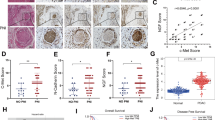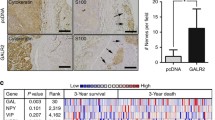Abstract
Background
Perineural invasion (PNI) is one of the important routes for local spread of gastric carcinoma associated with poor prognosis. However, the exact cellular characteristics and molecular mechanisms of PNI are still unclear.
Aim
To identify the interaction between gastric carcinoma cells and neural cells, and whether vascular cell adhesion molecule-1 (VCAM1) is involved in this process.
Methods
We adopted in vitro cell coculture assays to investigate the cellular and molecular interaction between gastric cancer cells and neural cells.
Results
We find upregulation of VCAM1 in clinical gastric cancer tissue samples. In in vitro tumor–neural cell coculture system, gastric cancer cells with high level of VCAM1 promote proliferation of neural progenitor cells and induce the process outgrowth and branching of neural cells. Reciprocally, neural cells enhance neurotropic migration and mobility of tumor cells. Repressing VCAM1 function through VCAM1 blocking antibody can attenuate these effects.
Conclusions
Our study indicates that VCAM1 is significantly involved in tumor invasion via mediating nerve–tumor interaction, which is a mutually beneficial process. It is possible that interaction between neural cells and tumor cells might contribute to PNI of gastric carcinoma. Inhibiting the activity of VCAM1 could be a potential strategy targeting PNI in gastric carcinoma therapy.




Similar content being viewed by others
References
Are C, Rajaram S, Are M, Raj H, Anderson BO, Chaluvarya Swamy R, et al. A review of global cancer burden: trends, challenges, strategies, and a role for surgeons. J Surg Oncol. 2013;107:221–226.
Siegel R, Naishadham D, Jemal A. Cancer statistics, 2012. CA Cancer J Clin. 2012;62:10–29.
Catalano V, Labianca R, Beretta GD, Gatta G, de Braud F, Van Cutsem E. Gastric cancer. Crit Rev Oncol Hematol. 2009;71:127–164.
Liebig C, Ayala G, Wilks JA, Berger DH, Albo D. Perineural invasion in cancer: a review of the literature. Cancer. 2009;115:3379–3391.
Marchesi F, Piemonti L, Mantovani A, Allavena P. Molecular mechanisms of perineural invasion, a forgotten pathway of dissemination and metastasis. Cytokine Growth Factor Rev. 2010;21:77–82.
Selçukbiricik F, Tural D, Büyükünal E, Serdengeçti S. Perineural invasion independent prognostic factors in patients with gastric cancer undergoing curative resection. Asian Pac J Cancer Prev. 2012;13:3149–3152.
Bilici A, Seker M, Ustaalioglu BB, Kefeli U, Yildirim E, Yavuzer D, et al. Prognostic significance of perineural invasion in patients with gastric cancer who underwent curative resection. Ann Surg Oncol. 2010;17:2037–2044.
Ayala GE, Wheeler TM, Shine HD, Schmelz M, Frolov A, Chakraborty S, et al. In vitro dorsal root ganglia and human prostate cell line interaction redefining perineural invasion in prostate cancer. Prostate. 2001;49:213–223.
Dai H, Li R, Wheeler T, Ozen M, Ittmann M, Anderson M, et al. Enhanced survival in perineural invasion of pancreatic cancer: an in vitro approach. Hum Pathol. 2007;38:299–307.
Wu TC. The role of vascular cell adhesion molecule-1 in tumor immune evasion. Cancer Res. 2007;67:6003–6006.
Chen Q, Massagué J. Molecular pathways: VCAM-1 as a potential therapeutic target in metastasis. Clin Cancer Res. 2012;18:5520–5525.
Semba S, Kodama Y, Ohnuma K, Mizuuchi E, Masuda R, Yashiro M, et al. Direct cancer-stromal interaction increases fibroblast proliferation and enhances invasive properties of scirrhous-type gastric carcinoma cells. Br J Cancer. 2009;101:1365–1373.
Ding YB, Chen GY, Xia JG, Zang XW, Yang HY, Yang L. Association of VCAM-1 overexpression with oncogenesis, tumor angiogenesis and metastasis of gastric carcinoma. World J Gastroenterol. 2003;9:1409–1414.
Kokovay E, Wang Y, Kusek G, Wurster R, Lederman P, Lowry N, et al. VCAM1 is essential to maintain the structure of the SVZ niche and acts as an environmental sensor to regulate SVZ lineage progression. Cell Stem Cell. 2012;11:220–230.
Garton KJ, Gough PJ, Philalay J, Wille PT, Blobel CP, Whitehead RH, et al. Stimulated shedding of vascular cell adhesion molecule 1 (VCAM-1) is mediated by tumor necrosis factor-alpha-converting enzyme (ADAM 17). J Biol Chem. 2003;278:37459–37464.
Rose DM, Cardarelli PM, Cobb RR, Ginsberg MH. Soluble VCAM-1 binding to alpha4 integrins is cell-type specific and activation dependent and is disrupted during apoptosis in T cells. Blood. 2000;95:602–609.
Shen Q, Goderie SK, Jin L, Karanth N, Sun Y, Abramova N, et al. Endothelial cells stimulate self-renewal and expand neurogenesis of neural stem cells. Science. 2004;304:1338–1340.
Zhou H, Hasni SA, Perez P, Tandon M, Jang SI, Zheng C, et al. miR-150 promotes renal fibrosis in lupus nephritis by downregulating SOCS1. J Am Soc Nephrol. 2013;24:1073–1087.
Zheng L, Sinniah R, Hsu SI. Renal cell apoptosis and proliferation may be linked to nuclear factor-kappaB activation and expression of inducible nitric oxide synthase in patients with lupus nephritis. Hum Pathol. 2006;37:637–647.
Dunn M, Morgan MB, Beer TW. Perineural invasion: identification, significance, and a standardized definition. Dermatol Surg. 2009;35:214–221.
Chen Q, Zhang XH, Massagué J. Macrophage binding to receptor VCAM-1 transmits survival signals in breast cancer cells that invade the lungs. Cancer Cell. 2011;20:38–49.
Marhaba R, Zöller M. CD44 in cancer progression: adhesion, migration and growth regulation. J Mol Histol. 2004;35:211–231.
Huang J, Zhang J, Li H, Lu Z, Shan W, Mercado-Uribe I, et al. VCAM1 expression correlated with tumorigenesis and poor prognosis in high grade serous ovarian cancer. Am J Transl Res. 2013;5:336–346.
Shioi K, Komiya A, Hattori K, Huang Y, Sano F, Murakami T, et al. Vascular cell adhesion molecule 1 predicts cancer-free survival in clear cell renal carcinoma patients. Clin Cancer Res. 2006;12:7339–7346.
Lu W, Hu Y, Chen G, Chen Z, Zhang H, Wang F, Feng L, et al. Novel role of NOX in supporting aerobic glycolysis in cancer cells with mitochondrial dysfunction and as a potential target for cancer therapy. PLoS Biol. 2012;10:e1001326.
Lorusso G, Rüegg C. The tumor microenvironment and its contribution to tumor evolution toward metastasis. Histochem Cell Biol. 2008;130:1091–1103.
Kulkarni S, Becker L, Pasricha PJ. Stem cell transplantation in neurodegenerative disorders of the gastrointestinal tract: future or fiction? Gut. 2012;61:613–621.
Estrada-Mondaca S, Carreón-Rodríguez A, Belkind-Gerson J. Biology of the adult enteric neural stem cell. Dev Dyn. 2007;236:20–32.
Natarajan D, Grigoriou M, Marcos-Gutierrez CV, Atkins C, Pachnis V. Multipotential progenitors of the mammalian enteric nervous system capable of colonising aganglionic bowel in organ culture. Development. 1999;126:157–168.
Kruger GM, Mosher JT, Bixby S, Joseph N, Iwashita T, Morrison SJ. Neural crest stem cells persist in the adult gut but undergo changes in self-renewal, neuronal subtype potential, and factor responsiveness. Neuron. 2002;35:657–669.
Acknowledgments
The study was supported by the National Nature Science Foundation of China (Nos. 81272698, 81101883, 81172368, 31200798), the Special Scientific Research Foundation of Health Sector from the National Health and Family Planning Commission of China (No. 20130206), the capital health research and development of special (No. 2011-5001-01), Major Science and Technology Project of “National Significant New Drug Creation” from the Major Science and Technology of China (No. 2011ZX09307-001-05), PLA medical and health research fund project (No. 11BJZ17), PLA Medical Technology key project of scientific research in the 12th research projects in 12th Five-Year-Plan (No. BWS12J049).
Conflict of interest
Qijun Xia, Qing-Ran Bai, Maosheng Dong, Xicai, Sun, Haihong Zhang, Hongqin Xi, Xiao-Ling Hu, Qin Shen and Lin Chen declare they have no conflict of interest.
Author information
Authors and Affiliations
Corresponding authors
Additional information
Qijun Xia and Qing-Ran Bai have contributed equally to this work. Lin Chen is the corresponding author of this article and Xiao-Ling Hu and Qin Shen are the co-corresponding authors.
Rights and permissions
About this article
Cite this article
Xia, Q., Bai, QR., Dong, M. et al. Interaction Between Gastric Carcinoma Cells and Neural Cells Promotes Perineural Invasion by a Pathway Involving VCAM1. Dig Dis Sci 60, 3283–3292 (2015). https://doi.org/10.1007/s10620-015-3758-x
Received:
Accepted:
Published:
Issue Date:
DOI: https://doi.org/10.1007/s10620-015-3758-x




